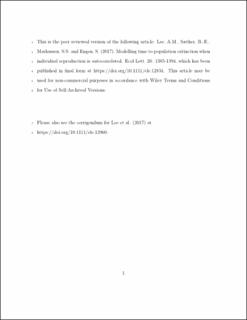| dc.contributor.author | Lee, Aline Magdalena | |
| dc.contributor.author | Sæther, Bernt-Erik | |
| dc.contributor.author | Markussen, Stine Svalheim | |
| dc.contributor.author | Engen, Steinar | |
| dc.date.accessioned | 2021-04-23T12:04:44Z | |
| dc.date.available | 2021-04-23T12:04:44Z | |
| dc.date.created | 2017-09-29T16:06:22Z | |
| dc.date.issued | 2017 | |
| dc.identifier.citation | Ecology Letters. 2017, 20 (11), 1385-1394. | en_US |
| dc.identifier.issn | 1461-023X | |
| dc.identifier.uri | https://hdl.handle.net/11250/2739358 | |
| dc.description.abstract | In nature, individual reproductive success is seldom independent from year to year, due to factors such as reproductive costs and individual heterogeneity. However, population projection models that incorporate temporal autocorrelations in individual reproduction can be difficult to parameterise, particularly when data are sparse. We therefore examine whether such models are necessary to avoid biased estimates of stochastic population growth and extinction risk, by comparing output from a matrix population model that incorporates reproductive autocorrelations to output from a standard age‐structured matrix model that does not. We use a range of parameterisations, including a case study using moose data, treating probabilities of switching reproductive class as either fixed or fluctuating. Expected time to extinction from the two models is found to differ by only small amounts (under 10%) for most parameterisations, indicating that explicitly accounting for individual reproductive autocorrelations is in most cases not necessary to avoid bias in extinction estimates. | en_US |
| dc.language.iso | eng | en_US |
| dc.publisher | Wiley | en_US |
| dc.title | Modelling time to population extinction when individual reproduction is autocorrelated | en_US |
| dc.type | Peer reviewed | en_US |
| dc.type | Journal article | en_US |
| dc.description.version | acceptedVersion | en_US |
| dc.source.pagenumber | 1385-1394 | en_US |
| dc.source.volume | 20 | en_US |
| dc.source.journal | Ecology Letters | en_US |
| dc.source.issue | 11 | en_US |
| dc.identifier.doi | 10.1111/ele.12834 | |
| dc.identifier.cristin | 1500603 | |
| dc.relation.project | Norges forskningsråd: 244647 | en_US |
| dc.relation.project | Norges forskningsråd: 223257 | en_US |
| dc.description.localcode | This is the peer reviewed version of an article, which has been published in final form at [https://doi.org/10.1111/ele.12834]. This article may be used for non-commercial purposes in accordance with Wiley Terms and Conditions for Self-Archiving. " | en_US |
| cristin.ispublished | true | |
| cristin.fulltext | postprint | |
| cristin.qualitycode | 2 | |
